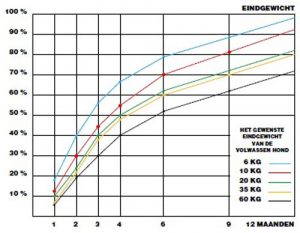Is your dog growing according to the growth curve?
The growth curve indicates how your dog should grow in the first year of life. By comparing the growth of your own puppy with the growth curve, you can see whether he is on schedule. If you weigh your puppy regularly and enter the weight in the table each time, you create your own growth curve.
Why is it important to follow the growth curve?
It is not good for your puppy if he lags behind in growth or if he becomes too heavy. Using the growth curve, you can keep control of this and intervene in time. For dogs of large breeds, control is very important. If there is a strong deviation from the growth curve, your dog will not develop properly. This can have consequences for the rest of his life. A puppy that is too heavy can suffer from his joints later in life and perhaps also from his heart and lungs. A puppy that is too thin is also not good, because the body should not lack anything during the growth phase.
The standard curve below shows that small breed puppies reach 90% of their final weight at 9 months of age, and large breed dogs only reach 60% at 9 months. In the first year of life, we must consider the feeding amount in relation to the breed.

Determine what your puppy can weigh and eat
The adult weight of a dog is the guideline for determining the weight of the puppy during the growth period. In the breed table below you can see what the adult weight of your dog should be. The adult weight is higher for a male than for a female. In the nutrition guide for Denkadog Growing Up Sensitive you can read what your puppy may weigh and eat.
1. Look at the top bar of the feeding guide to see what the expected adult weight (final weight) should be.
2. Look in the vertical column to see what the current age is.
3. Then you will see what the weight should be and what amount of Denkadog puppy food should be given.
We recommend puppies of breeds up to 30 kg adult weight: Denkadog Pup Junior Croc
We recommend large breed puppies over 35 kg: Denkadog Growing Up Sensitive.
An example
Suppose you have a:
- Bernese Mountain Dog
- 4 months old
- gender: female
Find the adult final weight to be achieved in the breed table below. The average weight for a Bernese Mountain Dog bitch is 45 kg. Go to the bar "final weight 45 kg".
Look at 4 (months) in the column "age in months". This 4-month-old Bernese Mountain Dog puppy may weigh 19.8 kg and may eat 520 grams of Denkadog Growing Up Sensitive per day.
NB :
At 6 months the optimal weight is 25.9 kg and the corresponding amount of food 490 grams Denkadog Growing Up Sensitive. per day and at 9 months this is 31 kg and the corresponding amount of food also 490 grams. This is correct because dogs of large breeds (more than 30 kg final weight) should not grow too fast. These breeds can experience growing pains at that age. The amount of food should not increase during that period.
The amount of food for a large breed puppy at the age of 4 to 9 months should not increase and can even decrease. This will prevent the puppy from becoming too heavy and the calcium intake will remain limited. Possible growth problems can be prevented in this way. Large breeds are breeds that weigh more than 30 kg at adult weight. Growing pains are caused by too much calcium absorption from the food, which can then cause pain in the front legs. Despite the non-increasing amount of food, sufficient nutrients are still entering the body. So you do not have to worry about that.
Dog height at the withers
The height at the withers of a dog is the distance between the ground and the withers. The withers is the space between the two shoulder blades behind the neck. This measurement is used to indicate which height a fully grown dog should be able to reach in principle for the breed characteristics. The height at the withers is not used in combination with growth.How long does a dog grow?
A dog grows on average until the first year. Small breeds may reach about 50% of their final weight in 3 months. Large to very large breeds may only reach 20/25% of their final weight in the same period. This means that large breeds, compared to small breeds, take twice as long to reach 95% of their final weight. A dog grows the most during the first year.
Are you feeding your puppy enough?
It is important that your puppy gets the right amount of food. The guidelines for this are on our packaging. It is important that you always keep a close eye on your puppy and adjust the amount of kibble to him.
Important for a good final weight is the basis. Do you give your puppy enough food? Check the daily feeding amount for your puppy.
Breed table (adult final weight male and female)
The table below shows the average weight per breed. By determining the final weight of your puppy, you can fill in the growth curve correctly. In this table you can find how much your adult dog may weigh. What is the adult weight of your puppy?| RAS | REU | BITCH |
|---|---|---|
| Affenpincher | 4 | 3 |
| Afghan Hound | 27 | 23 |
| Airdale Terrier | 25 | 22 |
| Akita Inu | 35 | 30 |
| Alaskan Malamute | 39 | 34 |
| Am. Staffordshire Terrier | 25 | 20 |
| Appenzeller Mountain Dog | 32 | 28 |
| Borzoi | 41 | 34 |
| Basenji | 11 | 10 |
| Basset | 35 | 28 |
| Broke | 14 | 13 |
| Bearded Collie | 25 | 20 |
| Bedlington Terrier | 8.5 | 8 |
| Bernese Mountain Dog | 50 | 45 |
| bloodhound | 45 | 41 |
| Bobtail (Old English Sheepdog) | 35 | 30 |
| Bordeaux dog | 50 | 45 |
| Border Collie | 25 | 20 |
| Boston Terrier | 12 | 7 |
| Bouvier | 40 | 35 |
| Boxer | 30 | 28 |
| Briard | 39 | 34 |
| Bulldog | 25 | 22.7 |
| Bullmastiff | 57 | 45 |
| Bull Terrier | 23 | 20 |
| Cairn Terrier | 7.5 | 6 |
| Cav. King Charles Sp. | 8 | 6.5 |
| Chihuahua | 3 | 2.5 |
| Chow Chow | 27 | 21 |
| Dalmatian Dog | 27 | 23 |
| Deerhound | 43 | 33 |
| RAS | REU | BITCH |
|---|---|---|
| Doberman | 37 | 29 |
| Drentsche Partridge Dog | 38 | 30 |
| German dog | 75 | 60 |
| German Shepherd | 38 | 32 |
| German Hunting Terrier | 8.5 | 7.5 |
| German Pinscher | 20 | 18 |
| German Shorthaired Pointer (Shorthair) | 30 | 24 |
| Pomeranian | 3.5 | 3 |
| Dwarf Pinscher | 3.5 | 3 |
| Miniature Poodle | 5 | 4.5 |
| Miniature Schnauzer | 5.5 | 5 |
| English Bulldog | 27 | 23 |
| English Cocker Spaniel | 14 | 13 |
| English Mastiff | 90 | 75 |
| English Setter | 30 | 27 |
| English Springer Spaniel | 21 | 19 |
| Finnish Spitz | 14 | 12 |
| Flatcoated Retriever | 32 | 28 |
| Fox Terrier | 8.5 | 7.5 |
| French Bulldog | 15 | 11 |
| Golden Retriever | 35 | 28 |
| Gordon Setter | 30 | 25 |
| Griffon Belge | 6 | 5.5 |
| Griffon Korthals | 28 | 25 |
| Greyhound | 29 | 26 |
| Groenendael | 28 | 23 |
| RAS | REU | BITCH |
|---|---|---|
| Heather watchdog | 17 | 15 |
| Dutch Shepherd | 30 | 27 |
| Dutch Smoushond | 12 | 9 |
| Hovawart | 35 | 33 |
| Irish Setter | 28 | 25 |
| Irish Terrier | 12 | 11 |
| Irish Wolfhound | 55 | 41 |
| Italian Greyhound | 3.5 | 3 |
| Jack Russell | 7 | 7 |
| Keeshond (large) | 19 | 18 |
| Kerry Blue Terrier | 18 | 15 |
| King Charles Spaniel | 8.5 | 7.5 |
| Standard Poodle | 21 | 19 |
| Kooikerhondje | 11 | 9 |
| Labrador retriever | 35 | 28 |
| Laekenois Shepherd | 28 | 23 |
| Lakeland Terrier | 7.5 | 7 |
| Leonberger | 70 | 50 |
| Lhasa Apso | 6 | 4 |
| RAS | REU | BITCH |
|---|---|---|
| Maltese Lion | 4 | 3 |
| Manchester Terrier | 7 | 7.5 |
| Mechelen resident | 28 | 23 |
| Pug | 8 | 6.5 |
| Newfoundland | 65 | 55 |
| Norfolk Terrier | 6.5 | 6 |
| Norwich Terrier | 6.5 | 6 |
| Papillon | 4 | 3 |
| Pekingese | 6 | 5.5 |
| Pointer | 30 | 25 |
| Pulis | 15 | 13 |
| Pyrenean Mountain Dog | 55 | 45 |
| Giant Schnauzer | 40 | 39 |
| Rottweiler | 55 | 45 |
| Saluki | 24 | 19 |
| Samoyed | 25 | 21 |
| sheepdog | 18 | 13 |
| Schnauzer (medium size) | 19 | 18 |
| Skipper | 6.5 | 4 |
| Scottish Shepherd (Collie) | 24 | 20 |
| Scottish Terrier | 24 | 20 |
| Sheltie | 8.5 | 7.5 |
| Shih Tzu | 7 | 4.5 |
| Siberian Husky | 24 | 20 |
| Saint Bernard | 80 | 65 |
| Skye Terrier | 11 | 7 |
| Stabyhoun | 25 | 20 |
| Staffordshire Bull Terrier | 15 | 13 |
| Dachshund (rabbit) | 3.5 | 3 |
| Dachshund (standard) | 8 | 7 |
| Tervueren Shepherd | 28 | 23 |
| Tibetan Terrier | 13 | 12 |
| Weimaraner | 27 | 23 |
| Welsh Corgi Cardigan | 11 | 10 |
| Welsh Corgi Pembroke | 10 | 9 |
| West Highland White Terrier | 9 | 7 |
| Whippet | 15.5 | 13.5 |
| Yorkshire Terrier | 3 | 2.5 |
The right food for your puppy
The right food is important for the growth of a puppy. Puppy food should not contain too much lime (Calcium), because too much calcium in the food can cause bone disorders in large breeds.
Denkadog has 2 variants for the puppy.

Denkadog Pup Junior Croc is the best basis for the growth and resistance of your puppy .
For more information about Denkadog Pup Junior Croc, visit: https://denkadog.nl/producten/denkadog-pup-junior-croc/

Denkadog Growing Up Sensitivesupports puppies and young dogs with sensitive intestines.
More information about Denkadog Growing Up Sensitive: https://den kadog.nl/producten/growing-up-sensitive/







